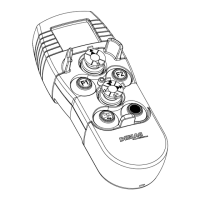17
211 338 44.indd / 081019
NOTE
If primary cells are used in the DRC-MJ D3 hand-held transmitter, it must not
be connected to the charger to avoid any damage caused by overheating
during the attempt to charge them.
i
In exceptional situations, if no charged batteries are available, the DRC-MJ D3
hand-held transmitter can be operated with two size AA (LR6) 1,5 V primary cells
to EN/IEC 60086. We recommend the use of Duracell and Varta brand alkaline
batteries. Primary cells cannot be recharged.
Observe local legal regulations for the correct disposal of old batteries and
rechargeable batteries.
Old batteries and rechargeable batteries must be given to regional recycling
systems or can be returned to us at no cost. They must never be disposed of with
domestic refuse.
6.3.3 Replacing the batteries The rechargeable batteries in the DRC-MJ D3 hand-held transmitter age as a
result of charging/discharging cycles and continuously lose their charge capacity.
We recommend that the rechargeable batteries be replaced after a year, at the
latest. Rechargeable batteries must be immediately replaced if the relevant icon for
a battery failure is displayed.
The NiMh rechargeable batteries supplied with the DRC-MJ D3 hand-held
transmitter have been specifically selected for the requirements of this radio
control system. The electric and mechanical features of the DRC-MJ D3 hand-held
transmitter and rechargeable batteries have been matched to fulfil all requirements
for smooth, safe and reliable operation.
For replacement, use rechargeable battery pack, part no. 773 499 44.
The use of non-approved rechargeable batteries can result in DRC-MJ D3 hand-
held transmitter operating malfunctions or lasting damage to the charger and the
DRC-MJ D3 hand-held transmitter.
When replacing the rechargeable batteries, check the contacts in the battery
compartment for sufficient contact pressure. New rechargeable batteries must fit
tightly between the contact surfaces.

